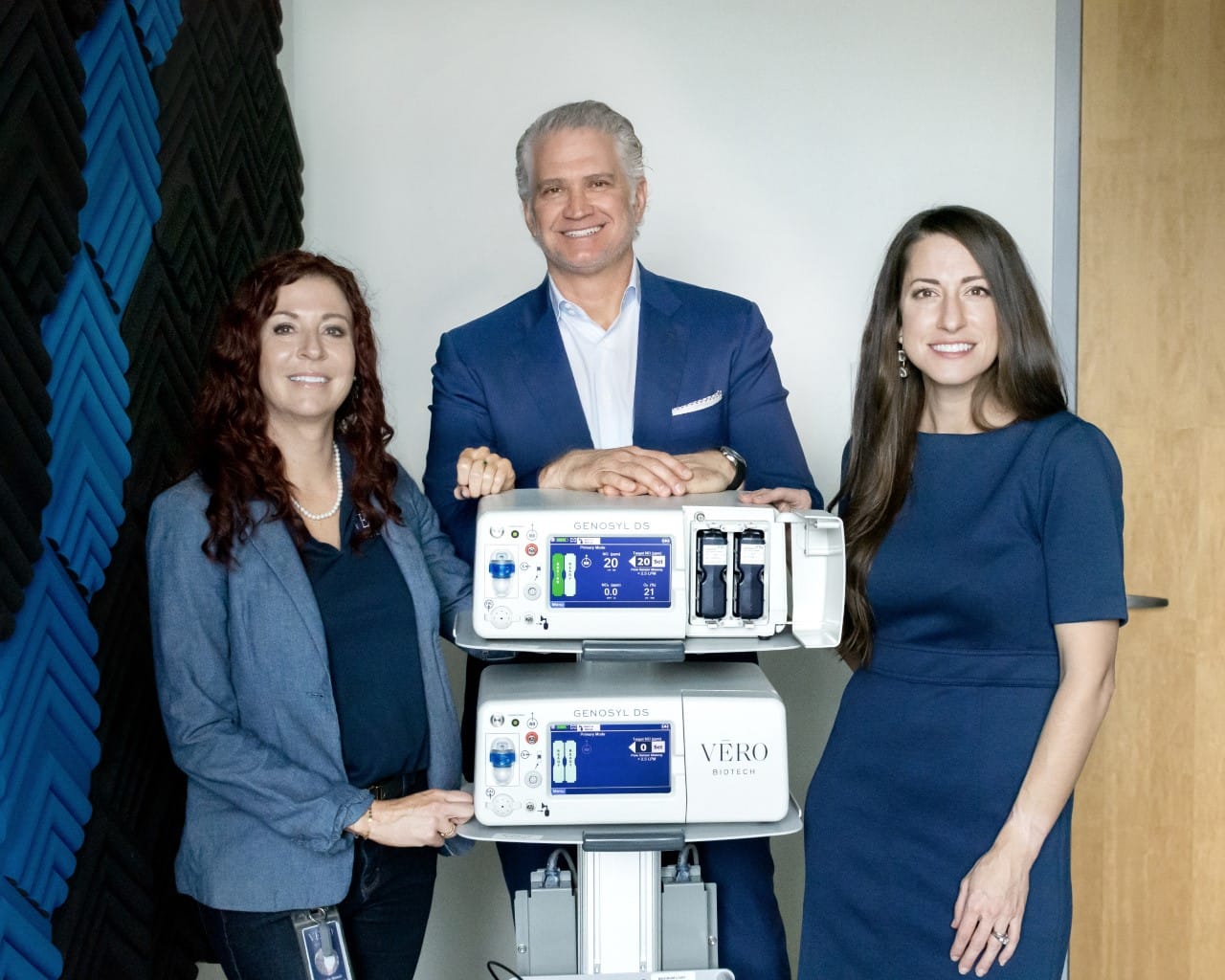RT magazine spoke with manufacturers of inhaled nitric oxide delivery systems about the latest market innovations in the iNO industry, specifically about the impact of cylinder-free (“tankless”) systems, plus research on its potential use to treat other cardiopulmonary diseases. Participating in the conversation were:
- Steve Lisi, CEO and Chairman of the Board for Beyond Air;
- Aaron Roebuck MS RRT, Director of Clinical Education for Vero Biotech.
RT: Use of inhaled nitric oxide therapy has been in practice in cardiorespiratory care for over 20 years. What is iNO currently indicated for and how does the therapy work?
STEVE LISI: In the United States, iNO is indicated to improve oxygenation and reduce the need for extracorporeal membrane oxygenation in term and near-term (>34 weeks gestation) neonates with hypoxic respiratory failure associated with clinical or echocardiographic evidence of pulmonary hypertension in conjunction with ventilatory support and other appropriate agents. This patient population is treated in the NICU and the iNO is administered by respiratory therapists.
In other areas of the world, including Europe, iNO is indicated for the same use as in the US, as well as for patients of all ages who are undergoing or have undergone heart surgery and develop pulmonary hypertension. In these patients, iNO is used to help improve heart function by reducing pulmonary vascular resistance. We are working on this in the US, with the FDA, to add to the product label.
AARON ROEBUCK: Inhaled nitric oxide (iNO) is a vasodilator indicated to improve oxygenation and reduce the need for ECMO in term and near–term (>34 weeks gestation) neonates with hypoxic respiratory failure associated with clinical or echocardiographic evidence of pulmonary hypertension.
When inhaled, nitric oxide (NO) selectively dilates the pulmonary vasculature, and because of efficient scavenging by hemoglobin, has minimal effect on the systemic vasculature.
This inhaled pulmonary vasodilator is administered by respiratory therapists throughout the hospital, and can be delivered during patient transport as well.1
RT: Although FDA approval for the therapy is limited to PPHN, it is being researched as a treatment for additional disease states, including viral and bacterial infections, and even COPD. What can you tell us about research into these diseases/disorders and what the data are revealing?

CEO and Chairman of the Board for Beyond Air
LISI: At Beyond Air, we have a robust, active pipeline focused on harnessing nitric oxide’s pulmonary, antimicrobial, anti-inflammatory, and immunomodulatory mechanisms of action.
Our clinical studies outside the US evaluate the use of high concentration iNO (80-250 PPM) generated from room air to treat lung infections. We recently presented favorable safety, tolerability, and efficacy results from our at-home pilot study in patients with refractory nontuberculous mycobacteria (NTM) lung infections treated with high concentration iNO using our portable LungFit GO System. We also released positive long-term safety data for high concentration iNO using our LungFit PRO System in hospitalized infants with acute bronchiolitis, and The Annals of the American Thoracic Society published a review of our third bronchiolitis pilot study. We’re planning to initiate a pilot study to evaluate the use of high concentration iNO to treat severe COPD exacerbations due to lung infections in hospitalized patients, pending FDA review.
Our studies have also demonstrated the safety of iNO at high concentrations in more than 12 clinical settings with over 170 patients treated and more than 5,000 treatments administered with only one serious adverse event possibly attributable to iNO.
ROEBUCK: Until recently, innovation in the NO delivery space has been little to none. With new technology now available, the focus on research into iNO therapy for various disease states and different areas of care is greater than ever. Vero Biotech is committed to saving lives, alleviating suffering, and contributing to the economics of healthcare. The GENOSYL Delivery System (DS) was designed for RTs by RTs, and we are keenly focused on research into usage of iNO for the treatment of many different disease states both in and out of the hospital.
RT: Specifically, there is new research that the therapy may treat patients with COVID-19-related pneumonia. What does the data reveal, regarding COVID-19?
LISI: We conducted a pilot study with the LungFit PRO System at 150 PPM of iNO to treat viral community-acquired pneumonia (VCAP), including COVID-19, and the safety and efficacy data is promising.
The data were presented at IDWeek 2022 from our multi-center study which included 35 patients randomized 1:1 where iNO plus standard of care was compared to standard of care alone. iNO treatment was safe and well tolerated with no treatment related adverse events.
We measured the time required for supplemental oxygen in the hospital setting, as well as the total time on prolonged supplemental oxygen in the hospital and home setting (patients were followed for 180 days). For both endpoints, iNO treatment resulted in a significant reduction in the times (with statistical significance at p<0.05 using a Cox proportional hazard model). 150 PPM iNO was administered 4 times/day for 40 minutes for up to 7 days with the LungFit PRO System.
We remain dedicated to bringing this important therapy to market as soon as possible and are in discussions with the FDA on a US trial design for VCAP, including COVID-19.

ROEBUCK: In 2020, GENOSYL was granted expanded access by the FDA for the treatment of patients with cardiopulmonary impairment and hypoxemia associated with COVID-19. Due to its ability to promote vasodilation and improve oxygenation, iNO has been and continues to be investigated in several studies as a potential therapy for patients with COVID-19. As a result, researchers are still in the process of collecting data, and we still have many questions about the efficacy of routine use and whether it has a meaningful impact on mortality.
A few public health organizations have released recommendations. The 2019 SCCM Surviving Sepsis Campaign Guidelines suggests a trial of an inhaled pulmonary vasodilator as a rescue strategy for mechanically ventilated adults with COVID-19, severe ARDS, and hypoxemia despite optimizing ventilation and other rescue strategies.2
The 2020 AARC Guidance Document states that in the absence of a response to PEEP, lung recruitment, or prone position (or a patient unable to be proned), an inhaled vasodilator might be considered for refractory hypoxemia.3
RT: How is iNO therapy traditionally delivered? What are some of the advantages and challenges with this delivery method?
LISI: Since 1999, iNO has been delivered with 800 PPM cylinders as a nitric oxide gas source. The cylinders typically weigh 45 lbs each and are pressurized to 2200 psi. The traditional delivery systems worked well, in fact, the inventors of the LungFit technology developed the first iNO delivery system. There is also user familiarity and comfort with these iNO delivery systems. While elements of the delivery technology have advanced and evolved to support patient safety and improved user experience, the bulky 45-lb cylinders have been a mainstay.
Logistics related to the management of cylinders pose the biggest challenges. The cylinders are heavy, cumbersome, require a large storage space, and used cylinders must be returned to the manufacturer. Additionally, cylinder-based iNO delivery requires physically monitoring cylinder emptying without the benefit of integrated reminder alarms. They also require meters as well as leak-testing, manual purging, and there is the potential for NO2 exposure associated with these tasks, which can be toxic. Lastly, there is the potential for iNO leaks and wasted iNO before patient use.
ROEBUCK: Inhaled NO has traditionally been delivered through systems reliant on large tanks of gas weighing about 45 lbs each. Storage and handling of these tanks can be a burden and are a workflow, safety, and logistical challenge within the hospital. Space is always in short supply in today’s healthcare facilities. Tank storage is generally relegated to the hospital loading dock, which takes up valuable hospital “real estate” and is inconvenient for quick access.
Data from a study of iNO use at a 300-plus bed children’s hospital suggest that hospitals incur substantial expense maintaining and managing a tank-based NO delivery system, especially for the “line items” of procurement, storage, data management, and labor costs for training and for response to frequent alarms (such as NO2 and wet sample line alerts). From these data it is estimated that the incremental cost of a tank-based system in a hospital where 250 patients receive 30,000 hours of iNO treatment per year is approximately $148,000.4
RT: The most recent innovation in nitric oxide therapy is the ability to generate iNO from room air. What benefits do this ‘tankless’ system provide over traditional cylinder-based delivery?
LISI: With The LungFit PH, we’re eliminating iNO cylinders at the bedside and quite literally taking the weight off the backs of respiratory therapists. Our technology empowers clinicians to generate unlimited, on-demand iNO from room air, verses burdensome cylinders and other approaches. Our system does this on-demand, with no reservoir of iNO in the system.
Additionally, the carrier gas is room air. The delivery system automatically purges the delivery line with room air, alleviating the potential for unintended NO2 bolus delivery to the patient. The LungFit PH System’s 2.5 oz NO2 Smart Filter, a patient safety feature which removes NO2 from the internal circuit, takes only a few seconds to replace. It can be stored at the point of care and lasts 12 hours regardless of dose or flow. We’re creating predictability for clinicians where it didn’t exist before. Being cylinder-free also means no more worries about meters or wasted iNO before patient use.
The LungFit PH System is the first and only 3-in-1 integrated system for iNO generation, delivery, and monitoring. Our system is fast, precise, and simple—generate and deliver iNO therapy within one minute. Generate what you need, when you need it.
ROEBUCK: Tankless iNO delivery systems help improve clinician workflow without the need to store, transport, and exchange large bulky gas tanks. With tank-based systems, a purge process is necessary to remove nitrogen dioxide (NO2) gas from the delivery path to ensure it doesn’t go to the patient. Tankless systems create iNO on demand, so there is no need to purge, which results in less exposure of NO2 to the environment. The GENOSYL DS uses tankless cassette-based technology and precisely delivers NO for inhalation via the Smart Feedback System, a closed loop feedback. This Smart Feedback System provides accurate dosing based on the sampled NO value measured close to the patient, regardless of changes in flow that may occur after injection, enabling use of iNO in setups that were not previously possible.
Two posters were presented at the Society for Technology in Anesthesia this month highlighting the GENOSYL DS cassette-based system as the first iNO delivery system to accurately deliver the set iNO dose with a semi-closed anesthesia circuit, using our Smart Feedback System. Anesthesia providers can simply set the iNO dose without adjusting fresh gas glow (FGF) or anesthetic agent. This has the potential to reduce provider distractions, maintain focus on the patient, and facilitate the transition of care between the ICU and OR for ventilated patients. The GENOSYL DS is the first iNO delivery system capable of accurately delivering iNO with an anesthesia machine under rebreathing conditions, enabling low FGF anesthesia with all its benefits.
In December 2022 Vero received FDA approval of the third generation GENOSYL DS with the following device enhancements:
- An Adaptive Sensor for secondary feedback control, improving time to achieve desired dose.
- A dual cassette bay in one console, allowing for single console engagement.
- Automated cassette activation enabling immediate initiation of dose.
- Console improvements that control cassette transition automatically and streamline clinician workflow.
- Smaller disposable cassettes that improve storage capacity in patient-centered areas.
- An improved user interface with easier-to-read screens and more efficient functionality.
RT: Will (more) portable, cylinder-free systems allow iNO to be administered in additional clinical settings, such as the home?
LISI: Absolutely, as noted above in our pilot study with NTM patients, the LungFit GO System was used successfully at home to generate iNO from room air, delivering 250 PPM intermittently over a 12-week period.
At the core of our LungFit family of products is the Ionizer technology which uses the power equivalent to a 60-watt light bulb to ionize the nitrogen and oxygen molecules to create iNO. The Ionizer platform allows for the generation of on-demand iNO in concentrations ranging from 0.1 to 400 PPM. The LungFit PH System generates between 0.1 to 80 PPM iNO (low concentration iNO), and the LungFit PRO and GO Systems both generate high concentration iNO for intermittent antimicrobial treatments. The LungFit PRO is designed for hospital use with supplemental oxygen, while the LungFit GO is for use at home.
Our cylinder-free generator systems also open opportunities for global access to iNO. Many areas of the world don’t have the infrastructure to support the logistics associated with 45-pound cylinders of iNO and as a result, don’t have access to this important therapy. We’re dedicated to empowering healthcare professionals across the globe with access to on-demand iNO from room air.
ROEBUCK: One of the many goals of having a more portable, tankless system is to allow for ease of use in all areas of care. GENOSYL DS is already being used in inter-hospital and intrahospital transport. Due to its smaller footprint, we envision a future where it may eventually be used even further away from the hospital, including in the home setting. In 2019, a case study demonstrated the successful use of GENOSYL DS by a COVID-19 positive patient who received outpatient iNO therapy while self-quarantined in her home.5 This study demonstrated the prospective, game changing potential of GENOSYL DS.
RT: What do these innovations and potential applications of iNO mean for respiratory therapists and critical care specialists? What will it mean for cardiorespiratory care departments?
LISI: Between the pandemic, hospitalizations for bronchiolitis and the flu, and a national RT staffing shortage, the demands on respiratory care professionals continue to increase. Our goal is to alleviate some of these demands by providing innovative iNO technology that’s easy to access and simple to use.
We’re dedicated to empowering respiratory therapists, critical care specialists, and cardiopulmonary care departments with additional opportunities to harness the power of nitric oxide for a range of cardiopulmonary conditions. From hospital to home, we see so much potential for the use of our LungFit technology.
ROEBUCK: The GENOSYL Delivery System opens the door for iNO therapy wherever and whenever it is needed. Already, Respiratory Therapists no longer need to worry about the limitations of other systems, including their inability to accurately deliver in rebreathing/recirculating environments. We believe that Vero Biotech has revolutionized NO delivery, and this is just the beginning of what is possible.
RT
For more information, contact [email protected].
References
- GENOSYL DS Full Package Insert, available at: https://www.vero-biotech.com/wp-content/uploads/2020/04/601531-GENOSYL-Final-Product-Label-Hi-Res.pdf
- Alhazzani W, et al., Surviving Sepsis Campaign Guidelines on the Management of Adults With Coronavirus Disease 2019 (COVID-19) in the ICU: First Update. Crit Care Med. 2021 Mar 1;49(3):e219-e234, available at: SSC-COVID19GuidelinesRecTable-FirstUpdate.pdf.aspx (sccm.org)
- American Association for Respiratory Care, Guidance Document: SARS COV-2, May 14, 2020, available at: guidance-document-SARS-COVID19.pdf (aarc.org)
- Bowen, R. W. et al., The Incremental Additional Costs of a Tank-Based System for Delivering Inhaled Nitric Oxide, Respiratory Therapy 16(2): 52-54, Spring 2021. Available at: https://respiratorytherapy.ca/pdf/RT-16-2-Spring-2021-R21.pdf
- Zamanian, RT, et al. Outpatient Inhaled Nitric Oxide in a Patient with Vasoreactive IPAH and COVID-19 Infection. Am J Respir Crit Care Med. 202(1), May 5, 2020, available at: https://www.atsjournals.org/doi/full/10.1164/rccm.202004-0937LE
.










